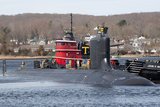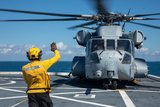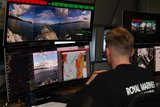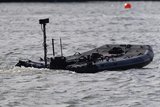Northrop Grumman unveils Manta Ray UUV
The Manta Ray programme has been developing UUVs which will be expected to be autonomous and able to operate in environments where humans cannot go. (Photo: Northrop Grumman)
A prototype of a Manta Ray-class vessel, part of a new class of UUVs developed to be energy-saving and able to anchor at the seafloor to rest in a low-power state, has been unveiled by Northrop Grumman.
According to the US defence company, the extra-large glider will be able to carry out tasks for long durations and ranges, as well as be equipped for payload-capable undersea missions.
DARPA stated that the UUV would be built as part of the US government agency’s Manta Ray programme, which has been exploring uncrewed systems that could enable traditional host vessels to operate with more flexibility and freedom.
Related Articles
DARPA taps Lockheed to design new large UUV
DARPA awards contracts for Phase 2 of Manta Ray programme
The project has included at-sea demonstrations and multiple phases while developing UUVs that remain independent of manned vessels and ports.
In 2020, DARPA approached Lockheed Martin to design an extra-large UUV powered by innovative energy management techniques for the Manta Ray project.
In 2021, DARPA awarded Phase 2 agreements to continue the Manta Ray programme to two prime contractors, Northrop Grumman Systems Corporation and Martin Defense Group, renamed PacMar Technologies. Each company was tasked with building and testing unique full-scale demonstration systems.
According to DARPA, PacMar conducted an in-water splash test with its prototype in 2023, testing the glider’s sensors, hydrodynamic performance and autonomy behaviour.
Related Equipment in Defence Insight
More from Naval Warfare
-
![UK to join US Navy’s Virginia-class submarine assembly effort to speed up construction]()
UK to join US Navy’s Virginia-class submarine assembly effort to speed up construction
The expansion of the Virginia-class submarine construction to UK shores could accelerate the project as US shipbuilders continue to fall short of delivery goals.
-
![US Navy seeks new sensors for the CH-53K King Stallion heavy-lift helicopter]()
US Navy seeks new sensors for the CH-53K King Stallion heavy-lift helicopter
The US Navy intends to publish a draft request for proposals in Q2 2026 and conduct an open competition for the supply of new electro-optical and infrared capabilities for the CH-53K heavy-lift helicopter.
-
![What new technologies could be involved in UK Atlantic Bastion initiative?]()
What new technologies could be involved in UK Atlantic Bastion initiative?
As new details emerge on the UK Royal Navy’s plan to secure the North Atlantic for the UK and NATO, three main areas of opportunity for new technology are the focal point.
-
![NATO naval exercises map out future USV requirements but raise questions on acquisition]()
NATO naval exercises map out future USV requirements but raise questions on acquisition
Uncrewed surface vessels have shifted from a desirable capability to a critical one for navies. But should these systems be bought outright, rented as a service or rapidly built using commercial off-the-shelf components?























